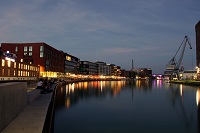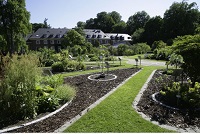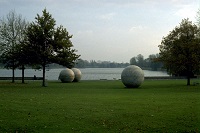About Münster
 With approximately 270,000 inhabitants and 48,000 students, Münster is the largest city in the Münsterland. The Münsterland is a rural region in the western part of Germany, famous for its castles and its distinguished history. As an academic and cultural city, Münster offers a wide variety of museums, theatres and events. The unique historic city centre, Lake Aa and the many parks and tree-lined avenues have made Münster a popular destination. Münster’s Aaseepark was awarded the title of "Europe’s Most Beautiful Park 2009".
With approximately 270,000 inhabitants and 48,000 students, Münster is the largest city in the Münsterland. The Münsterland is a rural region in the western part of Germany, famous for its castles and its distinguished history. As an academic and cultural city, Münster offers a wide variety of museums, theatres and events. The unique historic city centre, Lake Aa and the many parks and tree-lined avenues have made Münster a popular destination. Münster’s Aaseepark was awarded the title of "Europe’s Most Beautiful Park 2009".
Moreover, houses, churches and squares in the restored old town tell tales from different centuries but, at the same time, audacious modern architecture is artfully integrated within the city. Münster’s port has developed from a goods transshipment centre to a creative quay with cultural highlights like the port festival. Furthermore, Münster is also well known for its numerous traditional and modern gastronomic delights as well as its exciting nightlife.
It was no surprise that Münster was awarded the title of "Most Liveable City in the World" by the United Nations Environment Programme in 2004.
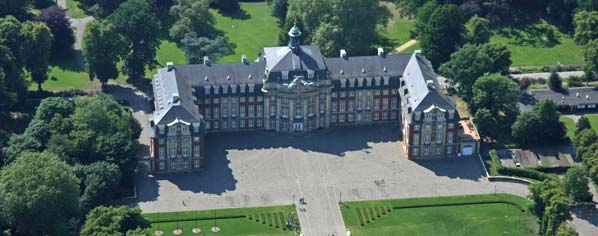
Historical background
In 793 Charlemagne sent out the Frisian Liudger as a missionary to convert the Saxons. On the right bank of the Aa Liudger built his church and cloister, the monastery ("monasterium") from which Münster derives its name. In the Middle Ages, Münster became a leading member of the Hanseatic League. The Baptists founded their empire in Münster, which ultimately turned into a reign of terror and perished in 1535.
.jpg/300px-The_Ratification_of_the_Treaty_of_Munster%2c_Gerard_Ter_Borch_(1648).jpg) The signing of the Peace of Westphalia in 1648 in Münster and Osnabrück ended the Thirty Years’ War and Eighty Years’ War and was one of the foundations upon which modern Europe was built. The peace treaties resulted from a large diplomatic congress, thereby initiating a new system in central Europe. The treaties’ regulations became integral to the constitutional law of the Holy Roman Empire.
The signing of the Peace of Westphalia in 1648 in Münster and Osnabrück ended the Thirty Years’ War and Eighty Years’ War and was one of the foundations upon which modern Europe was built. The peace treaties resulted from a large diplomatic congress, thereby initiating a new system in central Europe. The treaties’ regulations became integral to the constitutional law of the Holy Roman Empire.
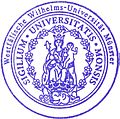 In 1780, the University of Münster was established. Today, the University of Münster is a major European centre for excellence in education and research with large faculties in the arts, humanities, theology, sciences, business and psychology. Furthermore, the numerous faculties and departments of the University of Münster are an integral part of the beautiful cityscape of Münster. As a result, the city of Münster was awarded the title of "Germany’s City of Science 2013".
In 1780, the University of Münster was established. Today, the University of Münster is a major European centre for excellence in education and research with large faculties in the arts, humanities, theology, sciences, business and psychology. Furthermore, the numerous faculties and departments of the University of Münster are an integral part of the beautiful cityscape of Münster. As a result, the city of Münster was awarded the title of "Germany’s City of Science 2013".
Münster is likewise famous for its renowned personalities. The Bishop of Münster in the 1940s, Cardinal Clemens August Graf von Galen, for instance, was one of the most prominent critics of the Nazi government. In retaliation, Münster was heavily garrisoned during the Second World War. After the bomb terror of the World War, the citizens of Münster rebuilt almost to the finest detail their historical old town.
Since 1977, the art is on display at the International Sculpture Projects, coining Münster’s international renown as a city of art. Every ten years, the "Sculpture Projects Münster" are held, constantly enriching Münster with many pieces of art in public spaces.
Sights
There are countless sights in Münster, some of the most famous being:
- The Aasee: This is Münster’s most central local recreation area. It’s only a 15-minute walk from the historic city centre as well as the congress venue and offers a variety of interesting leisure activities for young and old, including walking, sailing trips and visits to the zoo.
- The All-Weather Zoo: Is named for its "all weather walkways" that offer protection against rain or sun. In addition to the large animal houses and the BioCity which is concerned with the protection of species, there is a "Dolphinarium" and the Westphalian Horse Museum.
- The port: The particular charm of the municipal port of Münster lies in the mixture of restructured warehouses and modern architecture. Furthermore, the port of Münster has evolved into a unique dining venue.
- St. Paul’s Cathedral: Built in the 13th century in a mixture of late Romanesque and early Gothic styles and completely restored after the Second World War, it includes an astronomical clock from 1540, adorned with hand-painted zodiac symbols, which traces the movement of the planets and plays a Glockenspiel melody on the stroke of noon.
- The Prinzipalmarkt: The marketplace in the city centre with its Gothic town hall (14th century) in which the Peace of Westphalia treaty was signed in 1648.
- The Palace: Built in 1767–87 as residence for the prince-bishops by the Baroque architect Johann Conrad Schlaun and Wilhelm Ferdinand Lipper. Now the administrative centre for the University.
- The Botanischer Garten Münster: A botanical garden founded in 1803, now part of the university. This beautiful place is located directly next to the congress venue and is open to visitors.
- The Zwinger: The "Zwinger" fortress, built in 1528, was used from the 18th to the 20th century as a prison.
- The Mühlenhof: An open-air museum close to the Aasee, depicting a typical Westphalian village as it looked centuries ago.
- The City Museum: A large exhibition showing the political and cultural history of the city from its beginning to the present, housed by a converted former department store.
Explore Münster with the virtual tours through the city. Choose points of interest or enjoy one out of four themed tours to plan your own personal visit.
Further information
Planning a walk through the city? Check out the free audioguide, a 90 minute audio-tour with 20 audio-tour-stops and more than 200 pictures.
More information about living in Münster.



